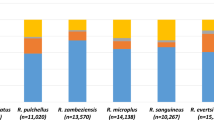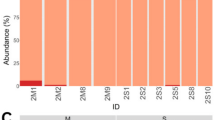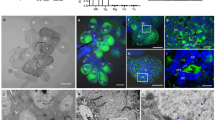Abstract
Nuttall and Hindle1 were the first to suggest that Theileria parva, which is the causal organism of East Coast fever in cattle, develops to the infective stage in its common tick vector, Rhipicephalus appendiculatus, only after the ingestion of blood by the tick. This finding was supported by Cowdry and Ham2 and, more recently, by Martin et al.3, who found the greatest numbers of parasites in salivary glands after 4 days of feeding although they did observe parasites in the glands after as little as 24 h. Infectivity therefore seems to be dependent on the feeding process.
This is a preview of subscription content, access via your institution
Access options
Subscribe to this journal
Receive 51 print issues and online access
$199.00 per year
only $3.90 per issue
Buy this article
- Purchase on SpringerLink
- Instant access to full article PDF
Prices may be subject to local taxes which are calculated during checkout
Similar content being viewed by others
References
Nuttall, G. H. F., and Hindle, E., Parasitology, 6, 321 (1913).
Cowdry, E. V., and Ham, A. W., Parasitology, 24, 1 (1932).
Martin, H. M., Barnett, S. F., and Vidler, B. O., Exp. Parasitol., 15, 527 (1964).
Bailey, K. P., Bull. Epizool. Dis. Afric., 8, 33 (1960).
Gregson, J. D., Canad. Entomol., 89, 1 (1957).
Chabaud, A. G., Ann. de Parasitologie, 25, 42 (1950).
Gregson, J. D., Mon. Rep. Entomol. Div. Kamloops, B.C., 4 (June, 1955).
Gregson, J. D., Acta Trop., 17, 48 (1960).
Gregson, J. D., Parasitology, 57, 1 (1967).
Author information
Authors and Affiliations
Rights and permissions
About this article
Cite this article
PURNELL, R., JOYNER, L. Artificial Feeding Technique for Rhipicephalus appendiculatus and the Transmission of Theileria parva from the Salivary Secretion. Nature 216, 484–485 (1967). https://doi.org/10.1038/216484a0
Received:
Published:
Issue date:
DOI: https://doi.org/10.1038/216484a0
This article is cited by
-
Artificial-membrane feeding of the ixodid tick,Rhipicephalus appendiculatus, to repletion
Experimental & Applied Acarology (1991)
-
A pathogenic theilerial syndrome of cattle in the Narok District of Kenya
Tropical Animal Health and Production (1972)
-
A convenient method of labelling ixodid ticks with radio-isotopes for future identification during field studies
Tropical Animal Health and Production (1971)
-
Attempted transmission of some piroplasms by rhipicephalid ticks
Tropical Animal Health and Production (1970)



